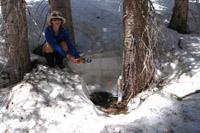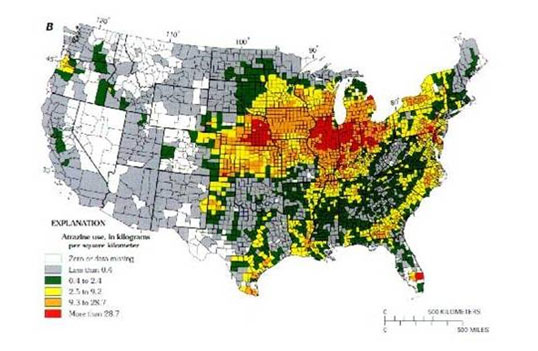- Home
- About S&T
- Taxa/Organisms
- Ecosystems
- Issues
- Methods & Tools
- Reports & Publications
- Location
- Search
Publisher: USGS | Science Center: USGS Other | Format: URL
nas.er.usgs.gov — This site has been established as a central repository for accurate and spatially referenced biogeographic accounts of nonindigenous aquatic species. The program provides scientific reports, online/realtime queries, spatial data sets, regional contact lists, and general information. The data is made available for use by biologists, interagency More...

Publisher: USGS | Science Center: Leetown Science Center (LSC, Kearneysville) | Format: URL
www.lsc.usgs.gov — The primary goal of this study is to clarify how riparian zone and land use affect T. tubifex population density, lineage and myxosporidian parasite density and/or the ability of resident worms to become infected with M. cerebralis spores and to release infective spores. Preliminary results suggest that a deciduous riparian zone reduces the More...

Publisher: USGS | Science Center: Fort Collins Science Center (FORT, Ft. Collins) | Format: URL
www.fort.usgs.gov — Encroaching development, overuse, and air- and waterborne contaminants from outside park boundaries are causing noticeable changes to water quality and ecosystem health and functioning. The Front Range metropolitan area from Fort Collins south to Colorado Springs includes 75 percent of Colorado's population and its most productive agricultural More...

Publisher: USGS | Science Center: Leetown Science Center (LSC, Kearneysville) | Format: URL
www.lsc.usgs.gov — Freshwater bivalves, which are among the most threatened animals in North America, present significant challenges to conservation biologists that attempt to maintain ecological and evolutionary processes within and among populations. Effective management of this rare fauna is often complicated because inadequate information exists for More...

Publisher: USGS | Science Center: Western Fisheries Research Center (WFRC, Seattle) | Format: URL
wfrc.usgs.gov — The whole study, conducted at Fort Benning, Georgia, partially funded through the US Army, involves testing of water and soil quality, physical and biotic indicators of stress at both the population and community level. Anthropogenic stress in the present study comes from disturbance by vehicles, particularly tanks used in army training, and from More...

Publisher: USGS | Science Center: Florida Integrated Science Center (FISC, Gainesville) | Format: URL
fl.biology.usgs.gov — The connection between fish habitat utilization, prey use, and fish movement patterns is not known in relation to available invertebrate prey resources in off-reef sites. Developing a better understanding of the habitat use, diet, and resource needs of benthic communities and their interactions with mobile fish and invertebrates is an important More...

Publisher: USGS | Science Center: Columbia Environmental Research Center (CERC, Columbia) | Format: URL
www.cerc.usgs.gov — The primary goal of the proposed research is to evaluate selenium and atrazine exposure and effects to fish, amphibians, and waterfowl that utilize the Refuge. The following subordinate objectives will be met to investigate selenium exposure and effects to wildlife on the Refuge: 1.Measure selenium concentrations and total organic content in More...

Publisher: USGS | Science Center: Forest and Rangeland Ecosystem Science Center (FRESC, Corvallis) | Format: URL
fresc.usgs.gov — Prescribed fire and forest thinning is a management strategy that promotes the development of forest structure and composition similar to that present under a native fire regime. This research summary describes how FRESC researchers will address the effects of prescribed fire and forest thinning on the diversity, abundance, and habitat More...

Publisher: USGS | Science Center: Upper Midwest Environmental Sciences Center (UMESC, LaCrosse) | Format: URL
www.umesc.usgs.gov — Fingernail clams (Sphaeriidae) and mayflies (Ephemeroptera) are important food sources for fish and migrating waterfowl in the Upper Mississippi River (UMR). An empirical model is being tested to determine its ability to confidently identify preferred areas for fingernail clams in UMR Pools 7 and 8. The intended result of this model is to provide More...

Publisher: NBII | Format: URL
www.nbii.gov — Natural resource managers face complex decisions that require a clear understanding of the status of wildlife populations and their habitats. Monitoring is key to making effective management decisions and evaluating the outcomes of those decisions. The goal of NRMP is to improve the accessibility of monitoring efforts to resource managers to aid More...

Publisher: USGS | Science Center: Fort Collins Science Center (FORT, Ft. Collins) | Format: URL
www.fort.usgs.gov — Natural Resource Monitoring Partnership (NRMP) is a collaborative effort by the natural resource management community to improve monitoring efforts in order to support effective evaluation and decision-making by sharing information on monitoring projects and protocols. The Natural Resource Monitoring Partnership was built for easy access to More...

Publisher: USGS | Science Center: Florida Integrated Science Center (FISC, Gainesville) | Format: URL
fl.biology.usgs.gov — Invasive nonindigenous species are important because they threaten native communities, alter habitats, and can have significant economic impacts. In aquatic environments, invasive species can be especially noxious because native species have few options for escaping direct interactions such as predation and competition for habitat and food. This More...
